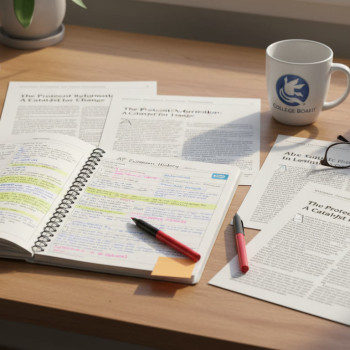Why Panic Spikes Happen — and Why They’re Not the End of the World
Walking into an AP exam feels like stepping onto the stage for a performance you’ve been rehearsing all semester. Even with great preparation, your body and brain can throw a curveball: a sudden rush of anxiety, a racing heart, blanking on a formula or historical date. These are panic spikes — sudden, intense moments of stress that temporarily hijack your attention and confidence.
The good news: panic spikes are extremely common, especially during high-stakes tests like AP exams. They’re a normal reaction to perceived threat. The better news: with simple tools practiced beforehand, you can reduce their intensity, recover quickly, and keep performing at your best.

The science behind the spike (briefly)
When you feel threatened — even by a difficult question — your sympathetic nervous system can activate, releasing adrenaline and cortisol. That increases heart rate, narrows attention, and primes you for “fight or flight.” On an exam, this shows up as tunnel vision, memory blanks, or impulsive answers. Recognizing this physiological pattern is empowering: it means there are predictable techniques that can down-regulate the response.
Before the Exam: Build a Resilience Toolkit
Prevention is the most effective way to handle panic spikes. The more you condition calm into your routine, the more automatic it becomes under pressure.
Daily habits that pay off on test day
- Consistent sleep: Aim for 7–9 hours in the week before the exam. Deep sleep consolidates memory and emotional regulation.
- Moderate exercise: Even a 20–30 minute brisk walk or jog reduces baseline anxiety and improves cognitive clarity.
- Small, regular study blocks: Spaced practice beats cramming. When your brain repeatedly retrieves information over time, it’s less likely to panic under pressure.
- Simulated practice tests: Take timed, full-length practice AP exams in conditions similar to the real thing — same timing, minimal breaks, realistic passage difficulty.
- Mindfulness practice: Five minutes a day of breathing or body-scan exercises increases your tolerance for stress during the test.
Create a pre-exam routine
Routines reduce uncertainty. On the morning of your AP exam, have a checklist: what to bring (photo ID, pens, pencils, acceptable calculator), a light carbohydrate-rich breakfast, arrival time, and a five-minute seated breathing session before the doors open. Practice the routine during a mock test so it feels familiar and soothing.
During the Exam: Fast, Practical Steps to Defuse a Panic Spike
When a panic spike hits during the exam, you want quick, reliable actions that restore control and attention. These methods are short, discreet, and effective.
1. The 4-4-8 breathing reset (30–60 seconds)
Breathing is the fastest route to calming your nervous system.
- Inhale quietly through your nose for 4 seconds.
- Hold for 4 seconds.
- Exhale slowly through your mouth for 8 seconds.
- Repeat once or twice until your heartbeat steadies.
This is subtle and exam-friendly — you can do it while sitting at your desk without drawing attention.
2. The 3-2-1 grounding trick (under 1 minute)
If your mind is racing or you’re blanking, switch sensory gears to reconnect with the present:
- List 3 things you can see around you (e.g., clock, pencil, top of the desk).
- Name 2 things you can feel (e.g., the texture of the paper, the weight of your pen).
- Identify 1 thing you can hear (e.g., the rustle of a paper, distant footsteps).
This technique interrupts catastrophic thinking loops and brings cognitive resources back online.
3. The question triage method (2–3 minutes)
Panic often comes from feeling stuck. Give yourself permission to triage:
- Mark and move: If a question stalls you for more than 90–120 seconds, mark it and move on. You’ll conserve time and momentum.
- Estimate and return: Make your best reasonable choice (if it’s multiple-choice) to buy time, then return if you have minutes later.
- Chunk breakdown: For long FRQs or essays, break the prompt into smaller parts: what does it ask? what evidence do you have? what’s your one-sentence thesis?
Practical Exam-Time Strategies — Walkthroughs and Examples
Below are concrete examples for common AP formats: multiple-choice heavy exams (e.g., AP Physics, AP Biology), free-response/essay formats (AP US History, AP English Language), and mixed exams (AP Calculus).
Multiple-choice heavy exam
- Read the question, underline key units or numbers, and predict an answer before glancing at choices. This reduces the lure of distractors.
- If stuck, use elimination: cross out clearly wrong options, then pick between the remaining two.
- Use the triage method to avoid spending too long on a single question.
Essay or AP-style free-response
- Spend 3–5 minutes planning: write a two-sentence thesis and a brief outline of your main evidence points.
- If panic disrupts your flow, pause for a 30-second breathing reset and rewrite the thesis at the top — the act of putting words on paper fights blanking.
- Use paragraph structure: claim, evidence, explanation. Even short paragraphs score points if they’re clear and supported.
Mixed-format exams (e.g., Calculus)
- Start with easier problems to secure points and build confidence.
- Label and show your work clearly — partial credit is real and often lifesaving during a spike.
- Use your calculator strategically: check units and obvious computation errors quickly before moving on.
Micro-Routines That Reduce Spike Intensity
Micro-routines are tiny, repeatable actions you can deploy in seconds. They’re powerful because they’re easy to practice and hard to forget under pressure.
Examples of micro-routines
- Touchpoint: Press your fingertips together for 10 seconds. It’s a discreet grounding cue.
- Anchor phrase: Have a short phrase you say silently, like “One step at a time” or “Breathe, read, answer.”
- Notebook cue: At the top of the exam, write a one-line promise to yourself: “I’ve prepared, I will do my best.” Reading it later can re-center you.
When Panic Spikes Create Physical Symptoms
Some students experience sweating, nausea, dizziness, or tremors. These are distressing but manageable.
Quick medical-smart steps
- Sip water slowly; swallowing helps regulate the vagus nerve and reduce nausea sensations.
- Lower your head briefly and do three deep belly breaths if dizziness occurs.
- If trembling makes handwriting difficult, slow your pace; neatly written short answers often score better than hurried messy ones.
Table: Quick Action Plan for a Panic Spike
| Time | Symptom | Action | Why it helps |
|---|---|---|---|
| 0–30 sec | Heart racing, hot | 4-4-8 breathing ×1–2 | Calms sympathetic nervous system |
| 30–60 sec | Racing thoughts | 3-2-1 grounding | Returns attention to present |
| 1–3 min | Stuck on a question | Mark and move; estimate if multiple-choice | Preserves time and momentum |
| 3–10 min | Ongoing symptoms | Tiny routine (touchpoint, anchor phrase) + sip water | Anchors cognition and soothes body |
Study Techniques That Reduce Panic on Test Day
Beyond immediate tactics, certain study habits make panic less likely and less powerful when it happens.
Active retrieval over passive review
Practice pulling information from memory (flashcards, practice tests, teaching someone else) rather than rereading notes. Active retrieval builds robust memory, which is the best antidote to freezing under pressure.
Interleaving and varied practice
Switch topics during study sessions (e.g., a bit of calculus, then physics, then a quick language review). This trains flexible thinking and reduces the shock of encountering an unfamiliar question type on test day.
How Personalized Tutoring, Like Sparkl’s, Can Help
Targeted, individualized support is especially useful for students who face recurring panic spikes. Personalized tutoring — such as Sparkl’s 1-on-1 guidance — offers several advantages that fit naturally into an anti-panic plan:
- Tailored study plans that address your knowledge gaps so you feel prepared rather than anxious.
- Practice tests with feedback focused on stress points: pacing, commonly missed question types, and time-management strategies.
- Expert tutors who model calm test behavior and coach you through breathing and grounding techniques during timed practice.
- AI-driven insights that show your performance patterns so you know exactly where to focus your energy.
These supports reduce the novelty and uncertainty that feed panic spikes, making exam day feel more like another practiced routine and less like an unknown performance.

Mindset Work: Reframing Panic as Utility
One surprisingly effective mental move is reframing. Instead of seeing adrenaline as only harmful, consider it a source of energy you can channel. Athletes do this all the time: they interpret nerves as excitement. You can too.
A short reframing exercise
Before the exam begins, try this: take the first inhale of your 4-4-8 routine and silently tell yourself, “This energy sharpens me.” Repeat once. Small shifts in interpretation change how your brain uses stress hormones.
After the Exam: Reflection Without Judgment
Whatever happened during the test, reflect in a way that helps future performance rather than punishing the past.
Constructive debrief template
- What went well? (List 2–3 things you did right.)
- What would I change? (Focus on one or two actionable steps for next time.)
- What support do I need? (Consider a tutor session, more timed practice, or mindfulness work.)
Use this template within 24 hours while memories are crisp, then move on. Dwelling heightens anxiety for future tests; purposeful reflection reduces it.
Real Students, Real Strategies — Short Examples
Example 1: Jasmine, AP Calculus AB — She would freeze on the second derivative questions. Her tutor coached her to start every problem by writing down given data and units; that micro-routine broke the freeze and recovered points.
Example 2: Luis, AP US History — He’d panic at long DBQ prompts. He learned to write a one-sentence thesis within three minutes and box it. That anchor calmed him and gave the essay structure judges could follow.
Frequently Asked Questions (Short and Practical)
Can I leave the room if I have a panic attack?
Exam proctors have policies. If you believe you need help, raise your hand and explain briefly. If you have a documented condition, contact College Board accommodations ahead of time to plan appropriate support.
Is it better to guess quickly or spend more time during a panic spike?
For multiple-choice, a quick, deliberate elimination and educated guess is often smarter than freezing. For essays, write a short outline or claim to create a path forward, then build on it.
Final Checklist: What to Practice This Week
- Three full-length timed practice sections with your 4-4-8 breathing used at least once during the session.
- Two sessions of 5-minute mindfulness or breathing practice daily for five days.
- One session with a tutor or study partner to role-play the exam environment and rehearse micro-routines.
- Write your pre-exam routine and practice it once under timed conditions.
Closing Thoughts: You’re More Capable Than You Think
Panic spikes feel huge in the moment, but they are short-lived and manageable with practice. The combination of preparation, quick in-test tactics, and supportive study habits turns an unpredictable crisis into a set of predictable actions. You don’t have to be perfectly calm to do well — you just need a few reliable tools and a plan.
If you want personalized guidance to make these strategies stick, consider a few targeted sessions with a tutor who can tailor practice to your strengths and stress points — for example, Sparkl’s personalized tutoring offers structured practice, expert feedback, and simple stress-management techniques you can use immediately. With the right preparation, you’ll walk into that AP exam more confident, more focused, and ready to show what you know.
Take one small step today: practice one breathing reset and one grounding trick. That small habit is the seed that grows into steadiness when it matters most.




















No Comments
Leave a comment Cancel